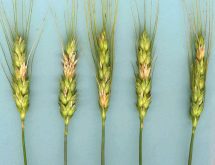In every one of the CWB’s major markets, the WTO’s proposed new “bound” tariffs are in fact higher than the tariffs actually being applied.
Talks have dragged on so long it’s tempting to think there won’t ever be a new World Trade Organization deal. But bit by bit, the elements of a final agreement are being assembled in Geneva. Once something gets into a draft, it can be very hard to get it out.
If the current draft goes through, western Canadian farmers will not only lose valuable government guarantees of our wheat and barley payments. We’ll also lose the right to choose our marketing structure for wheat and barley.
Read Also

Gene editing’s growing sway in plant breeding
Gene editing is becoming a baseline tool to drive innovation in Canadian crop research and new varieties.
The current draft specifically singles out and targets western Canadian farmers’ single desk for wheat and barley. The Canadian Wheat Board as it is today would cease to exist by 2013 – without western Canadian farmers having had any say in the matter.
This is in addition to costly concessions Canada has already made– costly to western Canadian farmers, that is. In 2004, Canada agreed to give up farmers’ financial guarantees on CWB initial payments and CWB borrowings. They’re not gone yet, but they will be whenever a WTO deal is reached and ratified.
The loss of government guarantees of initial payments means that farmers will no longer have the safety net of a floor price for those rare occasions when the bottom falls out of the market. The loss of government guarantees on CWB borrowings means that the CWB’s financing costs will go up. That means farmers’ costs will go up as well – and our net financial returns per bushel will go down.
Why is the WTO interested in our marketing structure? It’s a good question. It might make sense if the CWB were actually “trade distorting.” After all, the whole point of the WTO is supposed to be to reduce tariffs and subsidies that distort trade. But the CWB is not trade distorting. Fourteen consecutive international trade rulings – all initiated by the United States – have confirmed this. One of them is a 2004 WTO panel decision. In other words, the CWB shouldn’t even be on the table.
Whether it should be or not, however, it is.
STATE TRADING
The WTO refers to the CWB as a state trading enterprise (STE). There are many other organizations in the developed world that function like STEs, and they account for a greater share of world trade in their respective agricultural products than the CWB does in wheat and barley. However, the only other developed-world STE that the WTO formally
recognizes is New Zealand’s single desk for kiwi sales, Zespri. Zespri has been exempted from the proposed regulations concerning STEs – by former WTO agriculture chair Crawford Falconer of New Zealand.
Meanwhile, U. S. and EU domestic subsidies continue at high levels. In 2008, the U. S. implemented a $289-billion Farm Bill, which increased domestic support for wheat and barley. The U. S. Loan Deficiency Program is currently paying American farmers up to $1.53 per bushel of durum. The draft text does not require elimination of these programs.
Any negotiation is supposed to be about give and take. You give up something, and you get something in return. What will Prairie wheat and barley producers get in return for giving up their financial guarantees on initial payments and CWB borrowings?
Not much. The latest WTO draft contains a formula which is supposed to improve market access by reducing tariff levels. The problem is that it reduces “bound” or maximum allowable tariffs, not tariffs that are actually being applied. In fact, the current draft offers no significant gains in terms of market access for western Canadian wheat and barley producers. Check out the details on the CWB website under Hot Topics Trade issues WTO and market access. In every one of the CWB’s major markets for 2007-08, the proposed new “bound” tariffs are in fact higher than the tariffs actually being applied in these markets. In other words, there’s no benefit for wheat farmers.
STATED POSITION
The latest draft does eliminate export subsidies. That’s good as far as it goes, but export subsides are rarely used for wheat these days. As well, some progress has been made in addressing the export-subsidy aspects of the export credit and food aid sections of the text, but exceptions remain. Predictably, they favour the U. S.
As western Canadian farmers, the question we need to ask ourselves is whether this is the deal we want. If not, we need to insist that the government of Canada speak up on our behalf. The government’s stated position is a good one: that decisions regarding the CWB marketing structure “should be made in Canada and not by our international trading partners.” As a western Canadian farmer, I appreciate this. We deserve the right to decide the future of our marketing organization. However, a stated position benefits us only if it’s stated forcefully where it counts – at the WTO.
Western Canadian farmers need a WTO deal that provides meaningful reduction in tariffs for wheat and barley and an end to trade-distorting practices prevalent in the U. S. and EU. We don’t need a deal that will increase our financing costs and deny us the right to choose our own (non-trade-distorting) marketing structure for wheat and barley.
The next WTO meet ing of trade ministers is scheduled for Nov. 30 to Dec. 2 in Geneva. Now is the time for the government of Canada to speak up for western Canadian farmers at the WTO. Now is the time for farmers to ensure our elected representatives understand what’s at stake.
– Larry Hill chairs the Canadian Wheat Board’s board
of directors and farms near Swift Current, Sask.














